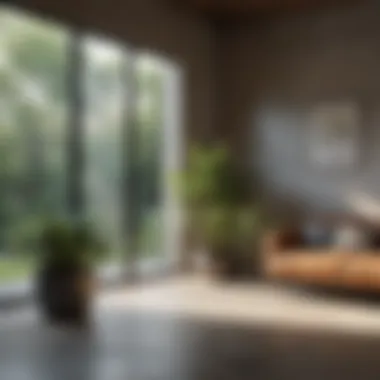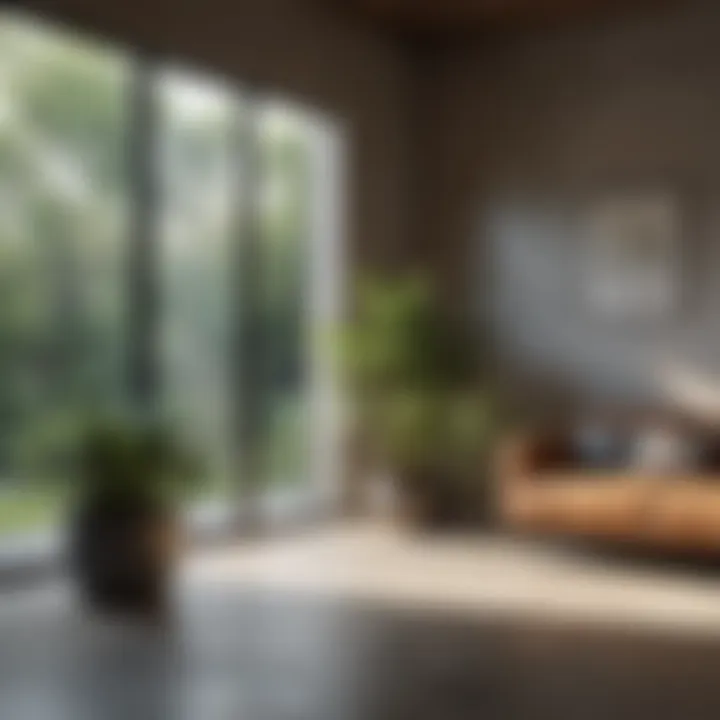Effective Strategies for Keeping Your Room Cool


Intro
Keeping a room cool is a priority for many homeowners, especially during hot weather. The following guide discusses effective strategies to maintain a comfortable living environment while also prioritizing energy efficiency.
Understanding heat transfer is crucial. Heat moves in and out of spaces through conduction, convection, and radiation. Effective cooling strategies often combine these principles, focusing on insulation and airflow. This article aims to provide a thorough examination of various methods, from conventional cooling techniques to innovative, sustainable practices.
Interior Design Tips
When considering how to keep your room cool, interior design choices can significantly impact temperature management. Here are some tips:
Trendy Design Ideas
Incorporating lightweight fabrics for curtains and furnishings allows for better airflow. Using natural fibers such as cotton or linen can help create a breathable space. Lightweight furniture helps avoid clutter, promoting a comfortable and airy atmosphere.
Color Schemes and Combinations
Cool colors tend to reflect light and create a calming environment. Pale blues, greens, and whites can help make a room feel cooler. Dark colors, in contrast, absorb heat, potentially raising the temperature. Choosing a cohesive color palette helps to maintain a serene environment.
Furniture Arrangement Techniques
Arranging furniture in a way that allows air to circulate freely is crucial. Positioning larger pieces away from windows can minimize heat absorption during hot sun hours. Leaving space around vents and fans ensures optimal airflow.
Practical Cooling Techniques
Insulation
Proper insulation helps reduce heat gain. Insulated windows and doors prevent warm air from entering the space. Adding insulation to walls and attics can further improve energy efficiency and comfort.
Maximizing Airflow
Strategies to enhance airflow might include using ceiling fans set to rotate counterclockwise. This creates a wind-chill effect that can lower perceived temperature. Opening windows during cooler parts of the day allows for natural ventilation.
Proper airflow and insulation are key components in creating a more comfortable living space.
Eco-Friendly Practices
Utilizing plants can help cool indoor air. Plants like snake plant and peace lily absorb heat and humidity. Additionally, using energy-efficient appliances can reduce overall heat generation while promoting sustainable practices.
The End
Successfully maintaining a cool room involves strategic interior design choices, effective airflow techniques, and an understanding of heat transfer principles. By combining these methods, homeowners can enhance their comfort while promoting energy efficiency. These strategies can also be adapted to suit various lifestyles and preferences, which is a vital aspect for modern living.
Understanding the Importance of a Cool Room
Maintaining a cool room is not just a matter of comfort; it is essential for both physical well-being and mental clarity. As temperatures rise, a cooler environment can significantly impact our daily lives. This section highlights the relevance of a cool room, focusing on the specific elements, benefits, and considerations associated with it.
Physical and Psychological Benefits
The benefits of a cool living space extend beyond mere comfort. From a physical standpoint, cooler rooms can assist in regulating body temperature effectively. Higher temperatures can lead to discomfort and fatigue, affecting productivity and focus. When your room is cool, the body can better manage heat, which can result in improved sleep quality and increased energy levels throughout the day. Moreover, certain studies suggest that cooler environments can enhance cognitive function. When the brain is not struggling with heat stress, it operates more efficiently.
On the psychological side, a cool room can also promote a sense of tranquility. Excessive heat often leads to irritability and restlessness. A well-ventilated, cool environment can create a peaceful atmosphere conducive to relaxation, making it easier to unwind after a long day.
Energy Efficiency Considerations
Energy efficiency is another critical aspect of maintaining a cool room. When temperatures soar, many homeowners turn to air conditioning units, which can significantly increase energy consumption. However, understanding how to keep your room cool without relying solely on mechanical cooling methods can have economic and environmental benefits.
By employing techniques such as proper insulation, strategic window treatments, and natural ventilation, one can reduce reliance on energy-intensive systems. For instance, using reflective window films can minimize heat from sunlight entering your home, while adequate insulation helps maintain cool air during hotter days. In essence, an energy-efficient room not only lowers utility bills but also contributes to environmental sustainability.
"Effective cooling strategies can save money and improve overall comfort, highlighting the intersection between personal well-being and environmental responsibility."
Principles of Heat Transfer
Understanding the principles of heat transfer is crucial for maintaining a comfortable indoor environment. This topic serves as the foundation for any strategy aimed at keeping a room cool. Heat transfer occurs in three primary forms: conduction, convection, and radiation. Each of these mechanisms has distinct characteristics and implications for how heat moves through materials and air.
Conduction: Heat Transfer Through Materials


Conduction is the transfer of heat through materials. This process happens when heat energy moves from a warmer part of a surface to a cooler part. Walls, roofs, and floors are the primary components where conduction plays a significant role. Materials with high thermal conductivity, such as metals, will transfer heat more efficiently than insulators like wood or fiberglass.
To effectively manage heat conduction, homeowners can start with insulation. Insulating materials can significantly reduce the amount of heat entering a room, especially during summer months. Understanding R-values, which measure thermal resistance, helps in selecting appropriate insulation.
Convection: Air Movement and Cooling
Convection refers to the transfer of heat through the movement of air or fluids. When air heats up in a room, it becomes less dense and rises, allowing cooler air to move in. This circulation can be encouraged or hindered, depending on how the space is designed. Proper ventilation strategies can enhance the cooling effect of convection.
For example, employing fans can assist in moving the air and improving circulation. Using ceiling fans in a counterclockwise direction during hot months can create a wind-chill effect, making occupants feel cooler without lowering the temperature significantly.
Radiation: Infrared Heating Effects
Radiation is distinct from conduction and convection in that it involves the transfer of heat through electromagnetic waves. Surfaces that absorb radiation can become hot, which in turn increases the overall temperature of a room. Sunlight is the primary source of radiant heat.
To mitigate unwanted radiant heat, homeowners can use window treatments, such as blackout curtains or reflective films, to block sunlight from entering a room. Planting trees or installing awnings on the exterior can also help limit radiative heat gain.
"Effective management of heat transfer is key to creating a comfortable living space, allowing for both comfort and energy efficiency."
By recognizing and applying the principles of conduction, convection, and radiation, individuals can develop strategies to improve cooling and achieve a more sustainable environment.
Insulation and Materials
Insulation plays a critical role in maintaining a cooler room. It acts as a barrier against heat transfer, ensuring that unwanted temperatures from outside do not infiltrate a space. Understanding how insulation and materials work together is essential for home and energy efficiency. Proper insulating materials can reduce the need for mechanical cooling, thus lowering energy costs. Good insulation not only contributes to thermal comfort but also reduces noise pollution, resulting in a more peaceful environment.
Choosing Insulation for Heat Retention
When selecting insulation, consider the R-value, which measures thermal resistance. A higher R-value indicates better insulation performance. Common materials include fiberglass, foam boards, and cellulose. Each has its pros and cons.
- Fiberglass is widely available and relatively inexpensive. It is non-combustible, making it safe for various applications.
- Foam boards provide high insulation and can be used in walls and foundations. They may be more expensive but offer excellent performance.
- Cellulose is eco-friendly and made from recycled materials, suitable for attics and wall cavities.
It is crucial to assess your home's specific needs, taking into account local climate and construction style. Proper installation is equally important. Gaps in insulation can lead to thermal bridges, negating the benefits.
Window Treatments to Block Sunlight
Windows are a significant source of heat gain in any room. A combination of effective window treatments can greatly contribute to room cooling. Consider the following options:
- Blinds and Shades: These can be adjusted to regulate sunlight entering the room. Opt for light-colored shades to reflect sunlight, while darker shades absorb heat.
- Tinted Glass: Installing tinted or reflective film on windows reduces solar heat gain without sacrificing natural light.
- Blackout Curtains: These heavy curtains can significantly lower room temperature by blocking out sunlight entirely when needed.
By strategically selecting window treatments, homeowners can improve indoor comfort while keeping energy costs low. Additionally, ensuring that windows are sealed properly prevents drafts that can undermine insulation efforts.
Ventilation Strategies
Ventilation strategies play a vital role in maintaining a cool environment in a room. Proper airflow not only reduces heat accumulation but also enhances indoor air quality. By implementing efficient ventilation, homeowners can leverage natural resources to manage temperature without relying solely on mechanical systems. This approach is beneficial both environmentally and economically.
Natural Ventilation Techniques
Natural ventilation techniques involve the use of natural forces, such as wind and temperature differences, to promote air circulation indoors. Utilizing these methods can significantly decrease reliance on energy-consuming cooling systems.
Cross Ventilation
Cross ventilation is the process of allowing air to flow through a space from one opening to another. This method effectively cools a room by creating a draft that enhances airflow. When windows or vents are strategically placed to face opposing directions, cooler outdoor air enters, pushing out warmer air. Cross ventilation is particularly popular in residential designs due to its simplicity and effectiveness.
The key characteristic of cross ventilation is the direct passage of air through a room, significantly reducing the overall temperature without mechanical aids. One of the unique features of this technique is its dependency on wind speed and direction; thus, its effectiveness can vary seasonally. Some advantages include the reduced cost of cooling and a lower environmental impact. However, disadvantages can arise in highly humid areas, where humidity may prevent effective cooling.
Stack Ventilation
Stack ventilation, also known as thermal or chimney ventilation, relies on the principle that hot air rises. It involves creating an upward draft to expel warm air through openings located higher on a structure. Cooler air is drawn in through lower openings, promoting a natural circulation of air throughout the room. This approach is effective in spaces with height, as the difference in temperature elevates the efficiency of the system.
The key characteristic of stack ventilation is its use of temperature differentials rather than wind pressure, making it an ideal choice for passive cooling in warmer climates. One of the unique features of this method is its functionality even in stagnant air conditions, which is beneficial during hot summer months. Advantages include lower operational costs and minimal energy consumption. However, it may require careful architectural planning to optimize vertical space for maximum benefit.
Mechanical Ventilation Systems
Mechanical ventilation systems include fans and HVAC units engineered to control indoor airflow actively. These systems are crucial in situations where natural ventilation is inadequate due to environmental factors or building design. Mechanical systems can offer enhanced control over the temperature and air quality, making them a preferred choice for many homeowners.
Advantages of mechanical ventilation include the ability to filter air and maintain a consistent temperature, regardless of external conditions. However, reliance on these systems requires consideration of their energy consumption.
"Implementing ventilation strategies can significantly enhance comfort and reduce energy costs."


In understanding and applying these ventilation strategies, homeowners can transform their living spaces into cooler, more comfortable environments while addressing energy efficiency.
Cooling Devices
Cooling devices are essential in maintaining a comfortable living environment, particularly in regions that experience extreme heat. The efficiency and effectiveness of these devices can greatly influence energy consumption and overall comfort in residential spaces. With various options available, understanding the nuances of each is critical in making informed decisions.
Air Conditioning Units
Air conditioning units are perhaps the most common method deployed for cooling rooms. They function by removing the warm air from inside the room and replacing it with cooler air, thanks to a refrigeration cycle. The key advantages of air conditioning systems include:
- Effective Temperature Control: These units allow for precise adjustments of the interior temperature to suit personal comfort levels.
- Humidity Regulation: They effectively reduce indoor humidity, contributing to a more comfortable atmosphere.
- Air Filtration: Many modern units come with built-in filters that improve air quality by trapping dust, pollen, and other allergens.
However, it is crucial to consider the energy consumption of air conditioning units. Running them continuously can lead to significant electricity bills. Homeowners should opt for energy-efficient models, potentially those certified by ENERGY STAR, to mitigate costs.
"Choosing the right air conditioning unit can represent a considerable investment, yet it is fundamental for comfort during hot seasons."
Fans and Their Efficiency
Fans are another viable cooling option that operates on an entirely different principle than air conditioning. They create airflow but do not lower the temperature of the air. There are several types of fans to consider, such as ceiling fans, stand fans, and table fans. The benefits of using fans include:
- Energy Efficiency: Fans consume significantly less electricity compared to air conditioning units, which can help lower energy costs.
- Flexibility: Easy to move and position as needed, they can be ideal for localized cooling.
- Improved Air Circulation: Proper use of fans can enhance air circulation throughout a room, aiding in creating a more refreshing environment.
To maximize efficiency, it’s advisable to run fans in conjunction with open windows during cooler evenings or mornings. This can increase airflow while minimizing heat gain during peak hours.
Evaporative Coolers: A Cost-Effective Alternative
Evaporative coolers, often referred to as swamp coolers, are an effective alternative to traditional air conditioning systems, particularly in arid regions. They operate by passing warm air through water-saturated pads, which cools the air through evaporation. The key benefits include:
- Lower Operational Costs: These coolers use less energy than air conditioning units, leading to lower utility bills.
- Humidity Addition: They add moisture to the air, which can be beneficial in dry climates where humidity levels are low.
- Eco-Friendly: With minimal refrigerants required, they generally have a lesser environmental impact compared to conventional air conditioners.
However, it is essential to keep in mind that evaporative coolers are most efficient in low-humidity environments. Homeowners should assess their local climate conditions before investing in this option, ensuring it aligns with their cooling needs.
In summary, selecting the appropriate cooling device involves weighing comfort against energy consumption and specific environmental considerations. Understanding the operational principles and benefits of air conditioning units, fans, and evaporative coolers allows homeowners to make choices that promote comfort while maintaining cost-effectiveness.
Impact of Landscaping
Landscaping plays a significant role in maintaining a cooler indoor environment. It involves not just aesthetic value but also functional benefits that can affect temperature regulation within a room. Homeowners can implement thoughtful landscape designs that contribute to thermal comfort. By managing heat gain through strategic greenery, it becomes possible to lower cooling costs and enhance overall energy efficiency.
Strategic Plant Placement
The placement of plants around the home is crucial. Trees and shrubs can provide shade, reducing the amount of direct sunlight that hits walls and windows. When positioning plants, consider their mature size and growth pattern. Large trees on the southern and western sides block intense afternoon sun. Smaller bushes can fill in gaps to create a buffer against heat.
Utilizing native plants that require less water also promotes sustainability. They help in decreasing heat absorption and can significantly cool the surrounding air through transpiration. This not only improves comfort but also enhances the overall air quality.
Using Trees for Shade
Trees are one of the most effective solutions for reducing indoor heat. They act as natural air conditioners by providing shade, reducing the amount of sunlight that penetrates the building. Strategic placement of trees can lower temperatures considerably. For instance, deciduous trees provide shade in the summer while allowing sunlight in during the winter when they shed their leaves.
Some specific benefits of using trees for shade include:
- Temperature Reduction: Trees can lower roof temperatures by up to 20 degrees Fahrenheit.
- Energy Savings: Reducing the reliance on air conditioning leads to lower energy bills.
- Increased Aesthetic Appeal: Trees enhance the visual appeal of the property while providing cooling benefits.
"The right landscape design integrates both beauty and function, creating a cooling oasis around the home."
In summary, thoughtfully designed landscaping can significantly impact room cooling. Homeowners should consider the placement of plants and trees to optimize shade and energy efficiency. This approach not only creates a comfortable environment but also contributes to long-term savings in energy costs.
Behavioral Adjustments
Behavioral adjustments play a critical role in maintaining a comfortable indoor climate. Homeowners often overlook how personal habits can influence the temperature in their living spaces. By being mindful of certain actions and timing throughout the day, it is possible to reduce the heat load and improve overall comfort. These slight modifications to daily routines can yield significant benefits in energy efficiency and indoor temperature, allowing for a more pleasant home environment.
Timing the Use of Appliances
Appliances generate heat when in use. Therefore, strategic timing can affect how cool a room feels. For instance, running the oven during the afternoon can significantly increase indoor temperatures, especially on a hot day. Instead, consider preparing meals early in the morning or later in the evening when outdoor temperatures are lower. Similarly, clothes dryers and dishwashers should be utilized during cooler hours, which can help in keeping the room temperature down.
Using appliances with a high heat output during peak heat hours can escalate energy consumption as well as discomfort.


"Timing your appliances wisely can minimize heat production and create a cooler environment within your home."
Consider running larger appliances, such as washing machines, at night. Most energy companies offer lower rates during off-peak hours. Additionally, switching to energy-efficient appliances can also reduce heat production. Appliances function more optimally at lower energy outputs, thus generating less heat.
Dressing for Comfort
Choosing suitable clothing can also contribute to a cooler living space. Wearing breathable fabrics, such as cotton or linen, allows for better air circulation around the body, keeping individuals comfortable without the need for added cooling devices. Loose-fitting attire can provide additional comfort by not retaining heat close to the skin. It is advisable to avoid synthetic fabrics that can trap heat, making the individual feel warmer.
In addition, adjusting clothing based on the time of day can further enhance comfort. Early mornings can be cooler, making it practical to wear layers that can be removed as the day heats up. This adjustment allows individuals to remain comfortable without relying heavily on artificial cooling solutions. Incorporating light and airy outfits during warmer months is a straightforward yet effective adjustment to personal comfort.
If you notice an increase in your indoor temperature, contemplate modifying your wardrobe. These simple changes can create a more conducive environment for relaxation without increasing the load on cooling systems.
Smart Home Technologies
Smart home technologies now play a significant role in maintaining a comfortable environment in our living spaces. The integration of devices such as smart thermostats and automated window treatments can greatly enhance cooling efficiency. These technologies provide not just convenience but also offer energy savings by optimizing how homes manage heat.
For homeowners, understanding these technologies means more than just convenience. It means creating a set of responsive systems that react to environmental changes and personal preferences. This understanding helps in the decision-making process when investing in smart devices. The earlier one embraces them, the better the effectiveness in managing indoor temperatures.
Thermostats and Sensing Devices
Smart thermostats are devices that learn the user’s schedule and preferences. By adjusting the heating and cooling accordingly, they can effectively help maintain a consistent indoor temperature. Many models connect to Wi-Fi, allowing users to control them via a smartphone app from anywhere.
Some key benefits include:
- Energy Saving: Smart thermostats can lead to significant savings on utility bills, as they prevent overcooling or unnecessary cooling during the day when homes are unoccupied.
- User Control: Users can set schedules or adapt preferences to seasonal changes effortlessly.
- Data Insights: These devices often provide reports on energy usage, helping homeowners understand their consumption patterns better.
Adopting smart thermostats can help make cooling your room much more efficient.
Automating Window Treatments
When it comes to managing sunlight and heat, automated window treatments offer a smart solution. These devices automatically open or close shades and blinds based on sunlight intensity or a predetermined schedule.
Key advantages of automating window treatments include:
- Passive Temperature Control: Adjusting blinds can block sunlight during the hottest times of the day, reducing heat gain.
- Convenience: Homeowners do not have to manually adjust window coverings, providing an effortless way to maintain comfort.
- Enhanced Privacy: Many systems allow for precise settings, ensuring privacy when needed without compromising on natural light.
Integration of smart home technologies is not just an advancement. It’s a proactive approach to creating a more comfortable and energy-efficient living space.
Cultural and Regional Considerations
Understanding the impact of culture and climate on cooling strategies is essential for devising effective solutions for maintaining a comfortable room temperature. Cultural preferences shape not only the design of homes but also the materials used and the technologies adopted for cooling. Regions with hot climates, such as Mediterranean or desert areas, often develop distinct architectural styles that incorporate natural cooling methods.
Cooling Strategies in Different Climates
In warmer climates, such as those found in southern regions, homes are typically designed with features that promote airflow and reduce heat retention. Houses may have high ceilings and large windows to facilitate cross-ventilation. In contrast, in colder climates, energy efficiency can take precedence over cooling needs, leading to less emphasis on open designs.
- Tropical Areas: In humid regions, like Southeast Asia, it is common to have both natural and mechanical cooling systems. High ceilings and shaded verandas are standard practices to enhance comfort. Additionally, the use of ceiling fans is ubiquitous to ensure air circulation.
- Temperate Zones: Areas experiencing both warm summers and cold winters may use thermal mass materials like concrete or stone, which can absorb heat during the day and release it at night, keeping the room more temperate.
- Desert Climates: In arid regions, homes often employ strategies like wind catchers and evaporative cooling systems that utilize the dry air to maintain a cooler environment. The choice of white or light colors for exteriors also reflects sunlight, further aiding in temperature management.
Architectural Styles and Heat Management
Architectural choices directly influence a building's ability to manage heat. In Mediterranean-style homes, thick walls and tiled roofs offer natural insulation against heat. These designs are effective in keeping interiors cool during hot months. In contrast, modern minimalistic designs often favor glass walls, which can significantly increase solar heat gain unless offset by advanced shading structures.
- Traditional Styles: Homes designed in harmony with the environment often feature extended eaves, which provide shade and reduce heat entering the building. This design philosophy minimizes reliance on mechanical cooling methods.
- Contemporary Approaches: Many new constructions utilize high-performance windows and efficient insulation, thus addressing climate change impacts while enhancing comfort. Smart building technologies, including thermal imaging and energy monitoring, also play a role in optimizing heat management in various architectural styles.
"Regional and cultural context shapes not only one’s living experience but also the interplay between comfort and energy efficiency in cooling strategies."
Culmination
The conclusion of this article on keeping your room cool serves as a comprehensive summary of the various strategies and practices discussed. It reinforces the key points that readers should take away, emphasizing the necessity of understanding both traditional and innovative cooling methods.
Recap of Key Strategies
- Understanding Heat Transfer: Knowing how conduction, convection, and radiation work allows you to make informed decisions about materials and designs that optimize cooling.
- Implementing Insulation Effectively: Selecting the right type of insulation and applying window treatments are essential to prevent unwanted heat from penetrating your living space.
- Enhancing Ventilation: Using both natural and mechanical ventilation techniques improves airflow, promoting a cooler environment.
- Adopting Cooling Devices: Choosing appropriate air conditioning units, fans, and evaporative coolers caters to varying needs while considering energy consumption.
- Leveraging Landscaping: Strategic placement of plants and trees can reduce heat gain, creating shaded areas that cool your living space.
- Adjusting Behavior: Behavior changes, like timing appliance use and dressing appropriately, contribute significantly to maintaining a comfortable room temperature.
- Incorporating Smart Home Technologies: Smart thermostats and automated window treatments help regulate room temperatures efficiently.
"Incorporating a blend of these strategies not only enhances comfort but also promotes energy efficiency, which is increasingly vital in modern living spaces."
Future Considerations in Room Cooling
Looking forward, the importance of evolving cooling strategies cannot be overstated. As climate conditions change, homeowners must remain adaptable. Here are some future considerations:
- Adopting Sustainable Practices: Embracing eco-friendly technologies and building materials will enhance energy efficiency and reduce environmental impact.
- Researching Advanced Cooling Solutions: Monitoring advancements in cooling technologies, such as phase-change materials and innovative ventilation systems, can offer new insights into effective room cooling.
- Regional Adaptations: Local climates will shape the cooling approaches usable in different areas. Homeowners should consider specific strategies suitable for their region.
This conclusion ties together the multi-faceted approaches to maintaining a cool room. Understanding these elements leads to improved life quality, fostering an environment that is both pleasant and energy-efficient.







